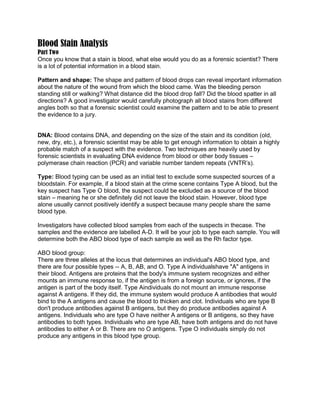Blood stain analysis
- 1. Blood Stain Analysis Part Two Once you know that a stain is blood, what else would you do as a forensic scientist? There is a lot of potential information in a blood stain. Pattern and shape: The shape and pattern of blood drops can reveal important information about the nature of the wound from which the blood came. Was the bleeding person standing still or walking? What distance did the blood drop fall? Did the blood spatter in all directions? A good investigator would carefully photograph all blood stains from different angles both so that a forensic scientist could examine the pattern and to be able to present the evidence to a jury. DNA: Blood contains DNA, and depending on the size of the stain and its condition (old, new, dry, etc.), a forensic scientist may be able to get enough information to obtain a highly probable match of a suspect with the evidence. Two techniques are heavily used by forensic scientists in evaluating DNA evidence from blood or other body tissues â polymerase chain reaction (PCR) and variable number tandem repeats (VNTRâs). Type: Blood typing can be used as an initial test to exclude some suspected sources of a bloodstain. For example, if a blood stain at the crime scene contains Type A blood, but the key suspect has Type O blood, the suspect could be excluded as a source of the blood stain â meaning he or she definitely did not leave the blood stain. However, blood type alone usually cannot positively identify a suspect because many people share the same blood type. Investigators have collected blood samples from each of the suspects in thecase. The samples and the evidence are labelled A-D. It will be your job to type each sample. You will determine both the ABO blood type of each sample as well as the Rh factor type. ABO blood group: There are three alleles at the locus that determines an individual's ABO blood type, and there are four possible types -- A, B, AB, and O. Type A individualshave "A" antigens in their blood. Antigens are proteins that the body's immune system recognizes and either mounts an immune response to, if the antigen is from a foreign source, or ignores, if the antigen is part of the body itself. Type Aindividuals do not mount an immune response against A antigens. If they did, the immune system would produce A antibodies that would bind to the A antigens and cause the blood to thicken and clot. Individuals who are type B don't produce antibodies against B antigens, but they do produce antibodies against A antigens. Individuals who are type O have neither A antigens or B antigens, so they have antibodies to both types. Individuals who are type AB, have both antigens and do not have antibodies to either A or B. There are no O antigens. Type O individuals simply do not produce any antigens in this blood type group.
- 2. TYPE A TYPE B TYPE AB Type O antigens A B A and B neither A nor B Anti bodies B A neither A nor A and B B

